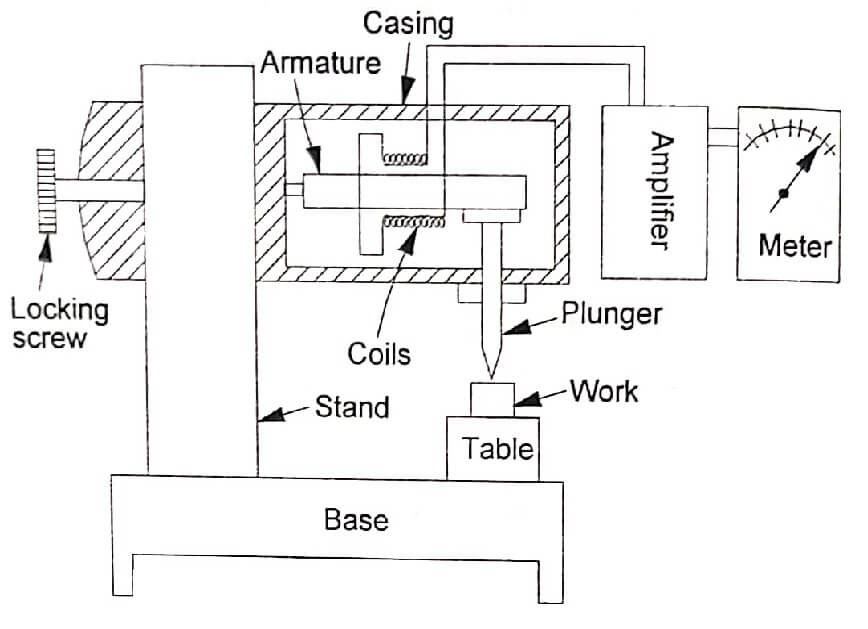Construction details : An electrical comparator consists of the following three major parts such as
- Transducer
- Display device as meter
- Amplifier

Transducer : An iron armature is provided in between two coils held by a leaf spring at one end. The other end is supported against a plunger. The two a coils act as two arms of an A.C. wheat stone bridge circuit.
Amplifier : The amplifier is nothing but a device which amplifies the given input signal frequency into magnified output.
Display device or meter : The amplified input signal is displayed on some terminal stage instruments. Here, the terminal instrument is meter.
Working principle of Electrical Comparator
If the armature is centrally located between the coils, the inductance of both coils will be equal but in opposite direction with the sign change. Due to this, the bridge circuit of A.C, wheatstone bridge is balanced.
Therefore, the meter will read zero value. But practically, it is not possible. In real cases, the armature may be lifted up or lowered down by the plunger during the measurement.
This would upset the balance of the wheatstone bridge circuit. Due to this effect, the change in current or potential will be induced correspondingly. On that time. the meter will indicate some value as displacement.
This indicated value may be either for larger or smaller components. As this induced current is too small, it should be suitably amplified before being displayed in the meter.
Checking of accuracy
To check the accuracy of a given specimen or work, first a standard specimen is placed under the plunger. After this, the resistance of wheatstone bridge is adjusted so that the scale reading shows zero. Then the specimen is removed.
Now, the work is introduced under the plunger. If height variation of work presents, it will move the plunger up or down.
The corresponding movement of the plunger is first amplified by the amplifier then it is transmitted to the meter to show the variations. The least count of this electrical comparator is 0.001mm (one microns).
Electronic comparator
In electrical comparator, transducer induction or the principle of application of frequency modulation or radio oscillation is followed.
Construction details : In the electronic comparator, the following components are set as follows:
- Transducer
- Oscillator
- Amplifier
- Demodulator
- Meter
Transducer : It converts the movement of the plunger into an electrical signal. It is connected with oscillator.
Oscillator : The oscillator which receives electrical signal from the transducer and raises the amplitude of frequency wave by adding carrier frequency called as modulation.
Amplifier : An amplifier is connected in between oscillator and demodulator. The signal coming out of the oscillator is amplified into the required level.
Demodulator : Demodulator is nothing but a device which cuts off external carrier wave frequency. It converts the modulated wave into original wave as electrical signal.
Meter : This is nothing but a display device from which the output can be obtained as a linear measurement.
Principle of operation : The work to be measured is placed under the plunger of the electronic comparator. Both work and comparator are made to rest on the surface plate.
The linear movement of the plunger is converted into electrical signal by a suitable transducer.
Then it is sent to an oscillator to modulate the electrical signal by adding carrier frequency of wave.
After that the amplified signal is sent to demodulator in which the carrier waves are cut off. Finally, the demodulated signal is passed to the meter to convert the probe tip movement into linear measurement as an output signal. A separate electrical supply of D.C is already given to actuate the meter.
Advantages of Electrical and Electronic comparator
- It has less number of moving parts.
- Magnification obtained is very high.
- Two or more magnifications are provided in the same instrument to use various ranges.
- The pointer is made very light so that it is more sensitive to vibration.
- The instrument is very compact.
Disadvantages of Electrical and Electronic comparator
- External agency is required to meter for actuation.
- Variation of voltage or frequency may affect the accuracy of output.
- Due to heating coils, the accuracy decreases.
- It is more expensive than mechanical comparator.
| Read More Topics |
| Electrostatic sensors and actuators |
| Standards of mutual inductance |
| Power and signal transmission |





